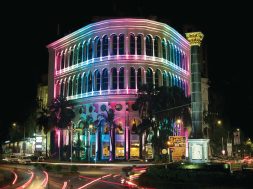Highlighting the role of HVAC in making a building green
With the depletion of natural resources around the globe, the demand for green buildings or environment friendly structures is on the rise. Green buildings are constructed or renovated under a design process that reduces the harmful impact on natural resources. In simplest terminology, green constructions are energy and resource efficient, non-wasteful and non-polluting, highly flexible and adaptable for long-term functionality; they are easy to operate and maintain, and are supportive of the productivity and well-being of the occupants.
Green building is a continually evolving concept in India and with all brain power and tools, the concept is sure to grow leaps and bounds in the near future. The highly energy-efficient green structures have low operating costs as compared to conventional constructions. The environment friendly designs help minimise environmental impacts to a large extent, such as water usage, ozone layer depletion and raw materials usage.
By optimising the building’s standard components such as site, windows, walls, floors, and HVAC systems, the owners can significantly reduce energy use and other negative impacts on the atmosphere without increasing the costs of construction.
Green building approach enables building owners and managers to reduce energy consumption, improve the work environment, and reduce the environmental impacts of building operations. Heating, ventilating, and air-conditioning (HVAC) systems account for nearly 40 to 50 per cent of the energy used in commercial buildings in India. Consequently, any commercial building has the potential to realise significant savings by improving its control of HVAC operations and improving the efficiency of the system it uses.
While explaining how HVAC helps in making a building green, Abhijit Pisal, Business Head – Green Building Consultancy Services, Godrej & Boyce Mfg Co Ltd says, “HVAC systems have an important role to play since many of the green building factors are directly or indirectly affected by the performance of the HVAC systems. An integrated and holistic design process beginning at a project’s inception is required to optimise the HVAC design and operation for green buildings.”
HVAC systems have an important role to play in a building being green since their performance affects, directly or indirectly, many of the building factors. It is often perceived that any infrastructure built with the vision of being green will have high heating and cooling costs. However, JR Tanti, Director, Synefra Infrastructures Pvt Ltd and Co-Chairman, IGBC Pune Chapter points out, “The fact is that HVAC equipment for a green building need not be expensive, but rather smaller, economical and less complicated. What needs to be remembered, though, is that the HVAC system has to be designed to reduce energy consumption while maintaining the interior conditions at a comfortable level. This ensures high productivity and good health of all occupants.”
Hence, an integrated and holistic design process that begins right at the inception of the project is required to optimise the HVAC design and operation for green buildings.
Energy conservation, maintaining the indoor air quality, and providing the right comfort are amongst the core green building concerns embraced by HVAC design. Ramdas Shenoy, Director Marketing, GIBSS, states that HVAC is more than a few pieces of mechanical equipment and one of the major energy guzzlers in any modern building. HVAC design follows other basic design procedures that could collectively reduce the size of the heating and cooling system. He adds, “With some basic interventions like doing the right sizing, sealing around electrical outlets and wall penetrations, and sizing of the ducts, one could bring down energy consumption but for major savings, one has to look at disruptive technologies like geothermal air-conditioning systems from GIBSS, which could bring down energy consumption by 50 to 60 per cent.”
A conventional AC system extracts heat from within the building and ejects it into the atmosphere. When the external ambient temperature is high (say 35 degrees to 50 degrees) the system is trying to exchange heat with an already hotter environment (i.e. the atmosphere). This reduces the efficiency of the system as it has to do more work to lose heat from within the building to a hotter environment. What if we were to replace this hotter environment by a much cooler environment, and constant temperature throughout the year, naturally the efficiency will be higher (Since the air conditioning system has to do less work). What about a winter like temperature throughout the year. This constant, cooler temperature environment is the ground! Ground below a particular depth is at a constant temperature of about 21 to 23 degrees.
In addition to the geothermal technology, Shenoy says that the geothermal technology is based on the principle of utilising the undisturbed ground temperature zone below the earth’s surface to build a geothermal interface to provide a constant temperature environment to the air conditioning system. This shall reduce the work done by the compressor to provide cooling in the building as it is interfacing with a temperature zone that is much cooler than the ambient environment temperature, thereby saving this 50-60 per cent energy every year. These systems being 100 per cent water efficient save millions of litres of water lost due to direct evaporation into the atmosphere and prevent usage of hazardous chemicals required for maintain these conventional systems. The life-cycle cost of a geothermal system is the lowest compared to any conventional air conditioning system as the economic life of this system, as per ASHRAE, is as high as 50 years.
On the other hand, Dr Anil Jindal, Chairman, SRS Group, predicts that HVAC’s future is bright as it has various qualities. He says, “HVAC control system and design are going to be the key components in making structures green due to its qualities that provide fresh air, controlling the temperature and controlling the environment of the building. The objective is to make every building green with the right technology, design and energy efficient solutions. Owing to the massive rise in the construction in India’s real estate market, the future of HVAC in India looks promising.”
There are also considerable opportunities for significant energy savings through efficient, integrated design, especially at the building envelope. An integrated and efficient building envelope with appropriate window, glazing design, insulated walls and roof can not only reduce the energy and operating costs of a facility, but can also reduce the size and cost of the HVAC system.
It should not only stop at this, but following the norm and meeting the standards is very crucial aspect in green building. On this note, Pisal and Tanti, shares similar views on the importance of standards, norms to make a green building.
Pisal suggests, “HVAC system for green building shall be designed to reduce energy consumption while maintaining the interior conditions at a comfortable level to keep occupants health and productivity. HVAC system design should not only meet the standard on energy front but out-perform the standard codes like Energy Conservation Building Codes (ECBC), India and American Society of Heating, and Refrigerating and Air Conditioning Engineers (ASHRAE) standards to achieve higher level of green building rating.”
“The designer should ensure the HVAC system design meets standards on the energy front, including the standards set by global organisations such as the Energy Conservation Building Codes (ECBC), India and American Society of Heating, Refrigerating and Air Conditioning Engineers (ASHRAE). By doing so, the HVAC system can become instrumental in achieving higher green building LEED (Leadership in Energy and Environmental Design) rating,” says Tanti.
In addition Tanti, suggests that designing green buildings, the following challenges need to be met and overcome:
• Create a low energy footprint.
• Norms such as CO2 monitoring, day lighting, Indoor Air Quality (IAQ) management and sustainable building material need to be addressed.
• Modular design needs to be incorporated in order to adapt future changes.
• CFC free environment needs to be created.
• Accommodation for varied loads as per heat distribution.
• Better efficiencies need to be achieved at part load.
• Compatibility with Integrated Building Management System (IBMS) needs to be ensured for effective monitoring.
• Ensure fresh air circulation and healthy air environment.
Pisal points out some of the following strategies that can be adopted in the HVAC system to meet green building requirements. He says, “Chiller or packaged AC unit selection to beat the energy efficiency specified in ECBC and ASHRAE standard; variable speed drives for pumps and fans; dedicated outdoor ventilation (DOAS) and demand control ventilation (DCV) based on CO2 monitoring to optimise on fresh air supply to the occupied space; supply air system control using variable air volume boxes and dedicated individual control for 50 per cent of the occupied people and heat recovery system. Some of the other advance technologies in HVAC are: Chilled beam systems, night pre-cooling, thermal storage system, displacement ventilation, and gas fired chillers (VAM). Conventional buildings operates at 150 to 200 sq ft per tonne whereas energy efficient green buildings nowadays operate at more than 400 sq ft per tonne.”
Speaking on the Indian context on the role of HVAC in making a building green, BB Kale, Head Product and Marketing, Emerson Climate Technologies Pvt Ltd says, “To support the green building movement the HVAC Industry will need to adopt latest technologies like variable speed drives that balance peak or off peak energy consumption and embrace the shift towards environment friendly refrigerants like R410A, R32. Professionals in the industry will need to design HVAC systems like chillers and packaged ACs that not only meet ISHRAE energy efficiency standards, but surpass them. They will also need to look at HVAC designs from a life cycle cost perspective, instead of looking at upfront costs.”
In the process of erecting a building, HVAC system forms the basis of building automation. It is a technology that provides an acceptable level of indoor air quality and thermal comfort
to the people. Solar orientation, insulation, window placement and design, even vegetation on the construction all directly affect heating and cooling loads. So, devising a system based on real demand, not conventional practice, is essential. HVAC is designed keeping in mind all such factors. They play a crucial role in energy conservation and maintaining the building environment by controlling the temperature, humidity and air quality in indoor spaces.
Building automation is responsible for monitoring and controlling the services within a structure and thus is an essential aggregator of the spread of HVAC systems in that space. On this note, Dr Jindal, says, “HVAC equipment are based on the principles of heat-transfer, thermodynamics and fluid mechanics that utilise almost 60 per cent of energy consumption in a building. These can collectively reduce the size of the heating and cooling system by 30-50 per cent.”
India can emerge as a manufacturing hub for HVAC industry given factors like growth of construction projects, low operating costs, optimised performance, demand and energy efficient solutions that are at their disposal. Dr Jindal shares the major advantages of implementing HVAC control systems are:
• Optimising functioning through central monitoring solutions for all discrete and standalone systems.• Implementing HVAC control systems saves costs by optimising usage of energy and utilities.
• HVAC control systems improves plant reliability and life and provides management dashboard for critical analysis.
• Integrating and managing the HVAC, energy, digital video and life safety applications from a single workstation allows facility-wide insight and control for better performance, growth and expansion of the system.
• The comfortable working environment increases the productivity of the working people dependent on that environment.
Conclusion
Green building is a continually evolving concept in India. Green building is basically an idea to save the buildings energy by optimising building’s standard components and HVAC systems. In this context, the article discuss about how HVAC systems plays an important role in making the building green. However with its various qualities to make a building green and increasing demand for the construction the future of HVAC seems to be bright.
——————–
HVAC equipment for a green building need not be expensive, but rather smaller, economical and less complicated.
JR Tanti, Director, Synefra Infrastructures
————————-
HVAC control system and design are going to be the key components in making structures green.
Dr Anil Jindal, Chairman, SRS Group
———————–
HVAC is more than a few pieces of mechanical equipment and one of the major energy guzzlers in any modern building
Ramdas Shenoy,Director Marketing,GIBSS
———————–
To support the green building movement the HVAC Industry will need to adopt latest technologies.
BB Kale, Head Product & Marketing, Emerson Climate Technologies Pvt. Ltd
——————————–
HVAC systems have an important role to play since many of the green building factors are directly or indirectly affected by the performance of the HVAC systems.
Abhijit Pisal, Business Head – Green Building Consultancy Services, Godrej & Boyce Mfg. Co
78
Cookie Consent
We use cookies to personalize your experience. By continuing to visit this website you agree to our Terms & Conditions, Privacy Policy and Cookie Policy.









